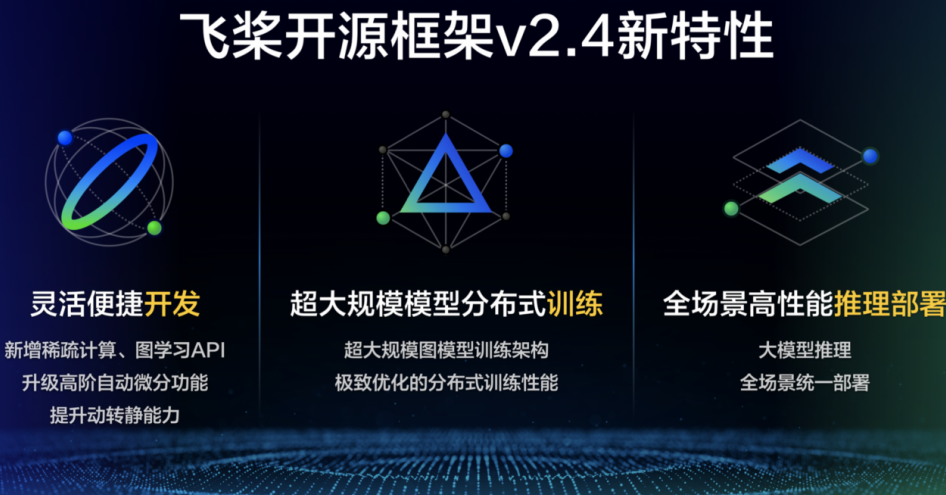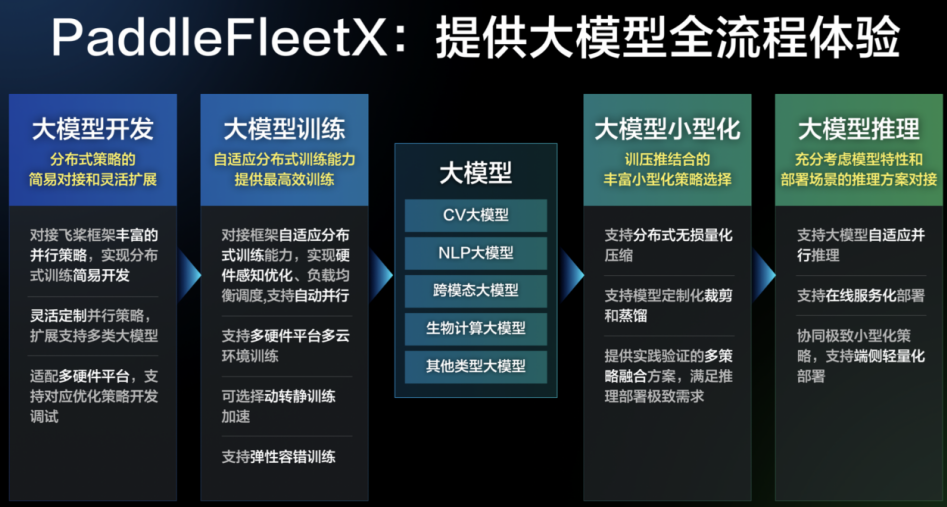12 hardware manufacturers released the flying paddle ecological distribution of soft and hard synergy
On November 30, the WAVE SUMMIT+2022 Deep Learning Developer Summit, hosted by the National Engineering Research Center for Deep Learning Technology and Applications and organized by Baidu Flying Paddle, was held as scheduled. At the summit, Ma Yanjun, General Manager of Baidu AI Technology Ecology, released the latest technical and ecological progress of the deep learning platform of Flying Paddle, the new release of the Flying Paddle open source framework version 2.4, bringing the industry’s first end-to-end large model development kit PaddleFleetX, the release of the Flying Paddle ecological distribution jointly with 12 hardware ecological partners, the upgrade of AI Studio learning and training community to launch enterprise practical training and Eco Heterogeneous Computing Center and more. This series of initiatives signifies that PaddleFleet continues to solidify the AI technology base and continue to deepen industrial integration and innovation.


Photo: Ma Yanjun, General Manager of Baidu AI Technology Ecology, shares the latest release of the Flying Paddle platform
Flying Paddle Open Source Framework Version 2.4 Released, Continuously Optimizing Performance with Underlying Technology Innovation
The upgraded version 2.4 of the flying paddle, the framework development is more flexible and convenient, large-scale model distributed training continues to lead, and realize the deployment of high-performance inference across the scene.

In terms of development, version 2.4 of the Flying Paddle open source framework adds more than 160 new APIs for important scenarios such as sparse computing and graph learning, and the API development threshold and cost are significantly reduced, so that 1/3 of the new APIs come from the contributions of ecological developers. For AI for Science scenarios, version 2.4 implements generic higher-order auto-differentiation functions to better support scientific computing related applications. At the same time, Flying Paddle has comprehensively improved the scalability and deployment flexibility of the core dynamic to static technology, with a 92% success rate of dynamic to static conversion of new models, giving full play to the respective advantages of dynamic and static graphs.
In terms of training, version 2.4 is newly upgraded with the introduction of PGLBox, a GPU-based training engine for super-large scale graph models, which is the first in the industry to realize an integrated graph learning solution that can support complex algorithms, super-large graphs, and super-large discrete models at the same time. In addition, Flying Paddle’s distributed training performance of aggregate communication has been optimized to provide a comprehensive and rich distributed training performance optimization system for large model training, based on which, Flying Paddle has won the first place in MLPerf Training list of international authoritative AI training benchmark test twice in a row this year.
As the “last mile” of AI implementation, the process of model inference deployment is very critical. First of all, for the reasoning of large models, Flying Paddle open source framework version 2.4 supports adaptive model slicing and distributed reasoning, etc. Relying on the dynamic to static capabilities of the Flying Paddle framework, automatic deep fusion and high-performance optimization can be achieved, fully supporting the implementation of large model applications. At the same time, in order to fundamentally solve the three major problems faced by AI application implementation: fragmentation of scenarios, high development cost and slow inference speed, FastDeploy, a full-scene high-performance AI deployment tool, is a one-stop solution to meet the deployment needs of multiple scenarios, multiple frameworks and multiple hardware in the end, edge and cloud, not only the API design is unified and easy to use, but also supports automated compression and high-performance inference engine deep linkage It not only has a unified API design and is easy to use, but also supports automated compression and high performance inference engine, which can give full play to the advantages of integration of hardware and software, and has industry-leading inference performance, providing the optimal solution for AI industrial application implementation.
Continuously reduce the application threshold and accelerate the implementation of AI applications
The application of large models can reduce the threshold of AI applications, but the process of large model development, training and inference deployment is still very challenging. In order to better support the implementation of large model applications, PaddleFleetX, an end-to-end large model development kit, has been released, which seamlessly connects to PaddleFleet’s parallel strategy and supports customized combinations, allowing developers to extend the support for more types of large models. and other multi-hardware platforms for training and debugging in multi-cloud environments. At the same time, PaddleFleetX also supports adaptive distributed inference technology, which truly achieves the integration of training and pushing of distributed strategies, which can support the service-oriented deployment of large models and the rich miniaturized strategies combined with training, pressure and pushing of small ones to realize the end-side lightweight deployment.

At the summit, the open source algorithms of the Flying Paddle Industrial Open Source Model Library were added to more than 600, covering mainstream task scenarios such as vision, natural language, and temporal modeling; the PP series of models with balance of accuracy and performance polished by industrial practice were added to 42; the number of examples of Flying Paddle industrial practice was increased to 68, covering ten key industry scenarios such as finance, industry, transportation, Internet, security, and education; the release of The one-stop portal of the industrial-level model library, aggregating model knowledge and toolsets, opens up the whole process of model selection, rapid experience, model development and use, and model deployment. The paddle from the industry model open source, example reference and other aspects of the accumulation of force, for enterprises to apply AI technology to provide convenient support, together to solve the industry pain points difficult.
Join hands with ecological partners in various fields to create and share together to build a prosperous AI ecology
To promote the application of artificial intelligence in the industry, it is inseparable from the hardware ecological partners to move forward. In May this year, Flying Paddle released the “Hardware Ecology Co-creation Plan” with hardware eco-partners to cooperate in joint R&D, resource sharing, joint licensing, training and empowerment, and other dimensions. As of November, the number of members of “Hardware Ecology Co-creation Plan” has increased from 13 to 28. At the same time, Flying Paddle has joined hands with 12 manufacturers, including NVIDIA, Arm, Cambium, Kunlun, Tensil, Graphcore, and Suigen, to jointly release the Flying Paddle Eco Distribution, which provides developers with a better integrated experience of hardware and software, and to build a prosperous hardware ecology.

In order to further accelerate the intelligent upgrade of AI industry, FeiPaddle goes deep into the industrial scenario, jointly with leading enterprises in the industry, such as National Energy Group, Industrial and Commercial Bank of China, China Unicom, China Petroleum, China Academy of Railway Sciences, China Mobile, China FAW, etc., and releases the industrial practice example collection plan, linking enterprises and developers, solving the key problems in the actual industrial scenario of each industry, and helping AI industry to land.
The AI Studio learning and practical training community built by Flying Paddle is dedicated to making AI learning and application easier, and has now also become the largest AI developer community in China. In this summit, AI Studio is upgraded with two new sections: Enterprise Practical Training and Ecological Heterogeneous Computing Center.
Enterprise training provides a practical training position for enterprises to apply deep learning. Up to now, Flying Paddle has jointly organized events with more than 20 well-known enterprises to explore AI application solutions and train AI talents. For a long time, AI Studio has provided rich arithmetic resources including CPU and GPU for the majority of developers, and has accessed Dawning DCU arithmetic power to provide online experience center for developers and a convenient experience environment for hardware infrastructure, and the ecological heterogeneous arithmetic center welcomes more hardware manufacturers to reside in.
The Baidu Flying Paddle deep learning open source platform, which originates from industrial practice, is an AI mass production platform for Baidu to practice convergence and innovation and lower the threshold. In the future, with the continuous deep plowing of deep learning core technology, the flying paddle will better support AI and large model landing applications, continuously build a more prosperous AI ecology, promote the industry to accelerate the intelligent upgrade, so that AI benefits thousands of industries.
